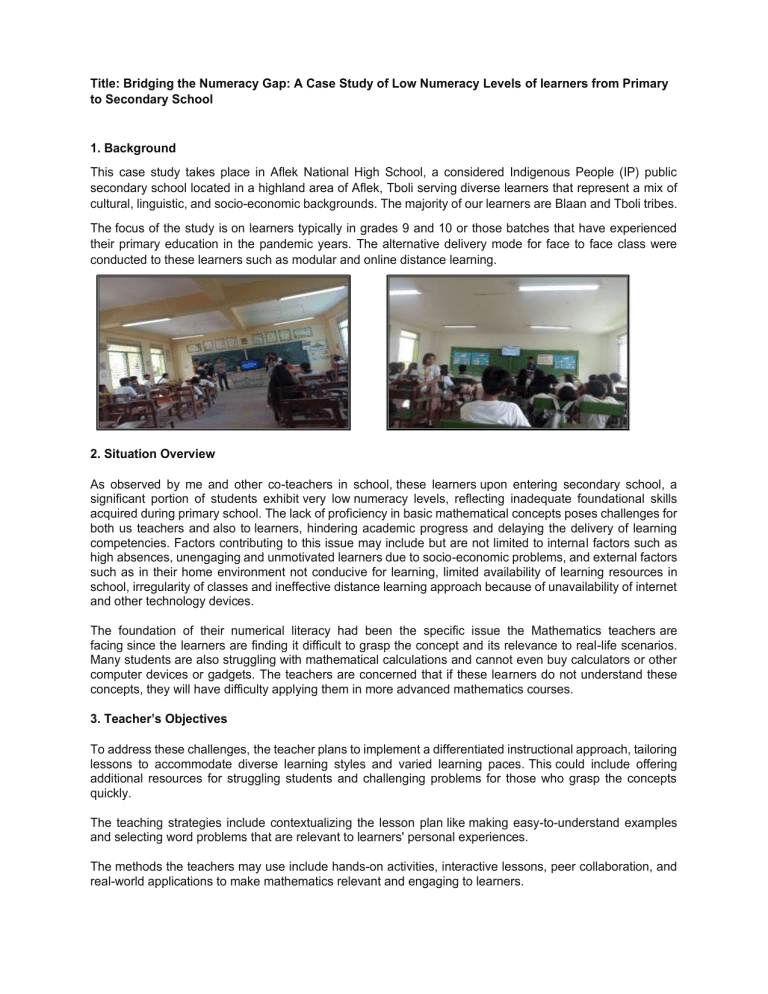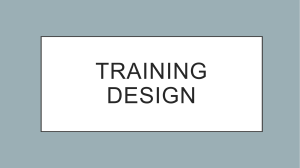
Title: Bridging the Numeracy Gap: A Case Study of Low Numeracy Levels of learners from Primary to Secondary School 1. Background This case study takes place in Aflek National High School, a considered Indigenous People (IP) public secondary school located in a highland area of Aflek, Tboli serving diverse learners that represent a mix of cultural, linguistic, and socio-economic backgrounds. The majority of our learners are Blaan and Tboli tribes. The focus of the study is on learners typically in grades 9 and 10 or those batches that have experienced their primary education in the pandemic years. The alternative delivery mode for face to face class were conducted to these learners such as modular and online distance learning. 2. Situation Overview As observed by me and other co-teachers in school, these learners upon entering secondary school, a significant portion of students exhibit very low numeracy levels, reflecting inadequate foundational skills acquired during primary school. The lack of proficiency in basic mathematical concepts poses challenges for both us teachers and also to learners, hindering academic progress and delaying the delivery of learning competencies. Factors contributing to this issue may include but are not limited to internal factors such as high absences, unengaging and unmotivated learners due to socio-economic problems, and external factors such as in their home environment not conducive for learning, limited availability of learning resources in school, irregularity of classes and ineffective distance learning approach because of unavailability of internet and other technology devices. The foundation of their numerical literacy had been the specific issue the Mathematics teachers are facing since the learners are finding it difficult to grasp the concept and its relevance to real-life scenarios. Many students are also struggling with mathematical calculations and cannot even buy calculators or other computer devices or gadgets. The teachers are concerned that if these learners do not understand these concepts, they will have difficulty applying them in more advanced mathematics courses. 3. Teacher’s Objectives To address these challenges, the teacher plans to implement a differentiated instructional approach, tailoring lessons to accommodate diverse learning styles and varied learning paces. This could include offering additional resources for struggling students and challenging problems for those who grasp the concepts quickly. The teaching strategies include contextualizing the lesson plan like making easy-to-understand examples and selecting word problems that are relevant to learners' personal experiences. The methods the teachers may use include hands-on activities, interactive lessons, peer collaboration, and real-world applications to make mathematics relevant and engaging to learners. Instructional resources include textbooks, PowerPoint presentations, online tutorials (YouTube videos), and educational software applications to supplement classroom instructions such as digital calculators to help learners visualize and calculate to solve word problems. 5. Implementation The teacher implements the instructional plan through a combination of whole-class instruction, small-group activities, and one-on-one support sessions. During the implementation phase, He will start each lesson with a real-life example that demonstrates the relevance of the topics in real-life so that they could easily grasp and understand the topics. He may use mother tongue language if needed to explain real-life examples and scenarios relevant to their culture to illustrate the importance of the topics. He may choose easy-tounderstand examples considering the low numeracy levels of the learners. He will then introduce the mathematical concepts using interactive tools and engage students in group activities and discussions. Continuous assessment informs instructional decisions, allowing for timely intervention and targeted remediation. The teacher will be flexible, adjusting teaching methods and pacing based on student progress and feedback. This may implies delay of learning delivery as scheduled but we need to compromise when needed by the situation. If most of these efforts are already done and some of the learners are still way below the passing rate, they will be identified and endorsed to summer class intervention and enhancement programs for Mathematics. 6. Evaluation and Reflection Evaluation is by formative assessment, performance tasks or activities, homework assignments, class discussions and anecdotal observations to assess the effectiveness of the instructional approach. The teacher will also ask feedback from students to identify any areas of confusion or difficulty. After each lesson, he will reflect on what worked well and what could be improved, making adjustments to his instructional plan as needed.Positive outcomes include improvements in student engagement, understanding, and confidence in mathematics. Reflection highlights the importance of ongoing professional development and collaboration with co-teachers to refine instructional practices and address evolving learners' need. 7. Challenges and Opportunities Challenges include limited learning resources, time constraints, and the different learning styles diverse needs of learners. Given this limitations, the challenge also to the teachers are to develop instructional planning that will tailor the needs of the learners and to identify the most effective teaching strategies. Opportunities for improvement lie in leveraging technology, community partnerships, and differentiated instruction to support student learning effectively. An opportunity for improvement is to incorporate more reallife examples and hands-on activities to make the learning experience more meaningful and engaging for students. 8. Recommendations Provide additional support and resources for struggling learners like learning recovery programs and Mathematics interventions, consolidations and enhancements. Invest in teacher training and professional development to enhance instructional strategies and differentiate instruction effectively. 9. Conclusion In addressing the issue of low numeracy levels among students in secondary school, this case study underscores the importance of differentiated instruction, engaging activities, interventions and enhancements, and continuing evaluation and reflection. By adopting a holistic approach that considers the unique needs and backgrounds of students, educators can empower learners to develop essential numeracy skills and achieve academic success. Prepared by: EMMANUEL F. MAGTANUM Math-10 Subject Teacher


